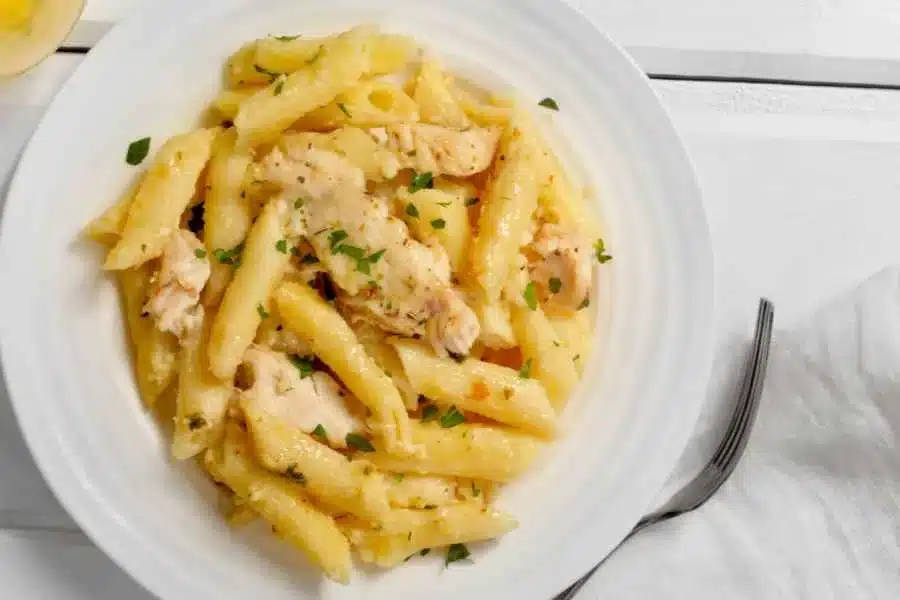Occhi di lupo means “wolf’s eyes” in Italian. The name comes from the way this pasta looks, with the hollow ends resembling a wolf’s pupils. It is made by extruding dough into long tubes and cutting them into tiny pieces.
Occhi di lupo pasta is very versatile and can be used in many Italian dishes. It goes well with creamy sauces, meat sauces, or simple vegetable preparations. You can even stuff it and bake it for a different twist.
In this recipe, the pasta is filled with a tasty mixture of ground meat, sauteed onions, garlic, and a savory tomato sauce with basil and oregano for that classic Italian flavor. Cheeses like ricotta, Parmesan, and mozzarella are used to add creaminess and savory goodness.
To make the “eyes,” you lay out a pasta sheet, spread a mixture of ricotta and Parmesan cheese on it, add some of the meaty tomato sauce, and then roll it up like a burrito. This creates little pasta rolls with a flavorful filling inside.
The story behind the recipe
The Baked Occhi di Lupo recipe comes from Italian cooking, which is known for its many regional dishes. Although there is not a single story about its creation, it is part of a broader tradition of Italian pasta and stuffed pasta dishes. Italy has lots of different pasta shapes. Stuffed pasta dishes like ravioli, cannelloni, and manicotti have been enjoyed in Italy for a long time. They often use pasta sheets to roll and stuff with tasty fillings.
The name “Occhi di Lupo,” which means “Eye of the Wolf,” is interesting and might have historical or folklore meanings. In Italian cooking, dish names often have cultural significance.
Recipes change over time as they are influenced by local ingredients, regional tastes, and people’s creativity. Baked Occhi di Lupo might have different versions in various parts of Italy. Many Italian recipes have been passed down through families, with each cook adding their own special touch. The recipe for Baked Occhi di Lupo could have started in a family kitchen, where it was perfected and cherished over the years.
While we may not know the exact story of how Baked Occhi di Lupo came to be, we do know that it represents the heart of Italian cooking, using simple, high-quality ingredients to make a comforting and delicious dish. It is a testament to Italy’s rich culinary heritage and its long-lasting influence on food around the world.
You May Like
How To Make Baked Occhi di Lupo

Ingredients:
- 12-16 circular pasta sheets (you can use either fresh or dried lasagna sheets)
- 1 pound of ground beef or pork
- 2 cloves of garlic, minced
- 14 oz crushed tomatoes
- 1/2 cup tomato sauce
- 1 small onion, finely chopped
- 1/2 cup ricotta cheese
- 1/2 cup shredded mozzarella cheese
- 1/2 cup grated Parmesan cheese
- 1 teaspoon dried oregano
- 1 teaspoon dried basil
- Salt and pepper to taste
- Olive oil for greasing
- Fresh basil leaves for garnish
Step-by-step instructions for making baked occhi do lipo:
- Preheat your oven to 375°F (190°C).
- In a big pan, heat some olive oil over medium heat. Add the chopped onion and garlic and cook until they turn see-through.
- Put in the ground meat and cook it until it’s brown and fully cooked. Break it into pieces with a spoon as it cooks.
- Add the crushed tomatoes, tomato sauce, dried basil, dried oregano, salt, and pepper. Let the sauce cook for about 10-15 minutes so the flavors mix together.
- While the sauce is cooking, bring a big pot of salted water to a boil. Cook the pasta sheets following the instructions on the package until they’re slightly firm. Drain and set them aside.
- In a bowl, mix the ricotta cheese and grated Parmesan cheese.
- Grease a baking dish with olive oil. Take one pasta sheet and spread a thin layer of the ricotta and Parmesan mixture on it. Then, spoon some of the meat sauce on the pasta sheet.
- Roll up the pasta sheet, like a cannelloni or enchilada, and put it in the baking dish with the seam-side down. Do this with the other pasta sheets.
- Once all the pasta sheets are filled and placed in the baking dish, pour the rest of the meat sauce on top.
- Sprinkle the shredded mozzarella cheese over the top of the dish.
- Cover the baking dish with aluminum foil and put it in the preheated oven for about 20-25 minutes.
- Take off the foil and bake for an extra 10-15 minutes or until the cheese is bubbly and golden.
- Let it cool a bit before serving. You can add fresh basil leaves on top if you like.
Tips for making baked occhi di lupo
- When boiling the pasta sheets, don’t cook them for too long. They should be cooked until they are slightly firm when you bite them because they will keep cooking in the oven.
- If you want to decorate your dish with fresh basil or another herb, do it right before serving. This keeps the herbs fresh and colorful.
- Use aluminum foil to cover the baking dish when you put it in the oven at first. This will stop it from getting too brown and make sure the pasta cooks evenly.
Flavourful substitute
- Pasta Sheets: You can substitute the round pasta sheets with other shapes of fresh or dried pasta sheets, like lasagna sheets.
- Use a meat substitute: Instead of ground beef or pork, you can go for ground turkey, chicken, or plant-based ground meat to create a vegetarian or vegan version.
- Ricotta Cheese: For a dairy-free or vegan version, you can use dairy-free ricotta cheese or tofu-based ricotta as a substitute.
- Parmesan Cheese: Use a dairy-free alternative or nutritional yeast for a vegan version.
- Tomato Sauces: You can replace the crushed tomatoes and tomato sauce with homemade or store-bought marinara or pasta sauce.
Serving suggestions
- Simple Salad: Serve with a fresh green salad dressed with vinaigrette to balance the richness of the dish.
- Garlic Bread: Accompany with garlic bread or breadsticks for a delightful side.
- Fruit Salad: Enjoy a light and tangy fruit salad with a hint of mint and citrus, which provides a refreshing contrast to the savory pasta.
- Italian Antipasto: Offer a selection of Italian antipasti such as olives, roasted red peppers, and marinated artichoke hearts.








